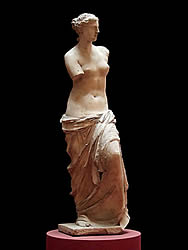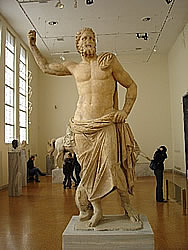 History of Milos
History of Milos
From historical data and findings it is demonstrated that there was human presence on the island since the Mesolithic period, around 8,000 years BC. The first inhabitants were probably Phoenician or Cares, while Milos obsidian found in the Franchthi cave in the Peloponnese (7,000-8,000 BC) and in the palaces of Crete (7,000 BC), show that Milos had begun to develop since the prehistoric period.
Thanks to its strategic location between the mainland of Greece and Crete, the natural and safe harbor and mainly thanks to the export of obsidian (black, hard, volcanic rock that was used for weapons and tools), Milos was one of the first islands of the Aegean, which prospered and began to generate significant culture.
The scattered huts that the people of Milos lived in during the Neolithic era were abandoned and most rural communities gathered together in a large settlement, Phylakopi. Apart from a major centre of the Cycladic culture, Phylakopi is considered one of the first cities with a history more than 1500 years old. The settlement was inhabited since 3,000 BC and was abandoned 1,100 BC having gone through three historical periods.
With the abandonment of Phylakopi, Dorians settlers from Laconia settled on the island and united with the previous inhabitants, they built a new city west to the current site of Klima. The inhabitants fortified it with walls that reached the sea and created large public buildings, the ancient theatre, aqueduct, school, market, temples and a cemetery. The city of Klima has strong economic and cultural development. The pottery is flourishing with its famous "Melian amphorae" decorated with elements of Greek mythology, sculpture, miniature art, the seals on stones, the jewellery with filigree and minted coins initially with the symbol of the apple on them. Also present at the time was the increased trade, exploitation of minerals, while the local “Milian”-alphabet developed and script samples are preserved until today in tombstones.
In the Persian Wars the people of Milos fought together with the other Greeks against the Persians. They also participated in the Battle of Salamis (480 BC) and the battle of Plataea (479 BC) by sending a team of soldiers to fight alongside the Spartans. In the Peloponnesian war, however, they tried to keep a neutral stance. Refusing to Athens to participate in the Athenian Delian League led to months of siege and ultimately a total disaster. 426 BC the Athenians sent general Nicias with 60 triremes and 2000 gunners to enforce Milos into a membership with the Alliance. Despite the damage, the island was not occupied at this time. 10 years later, however, at the instigation of Alcibiades a new Athenian campaign begins, led by Cleomedes and Tisia. After unsuccessful negotiations, 3000 men besieged Milos for almost two years. They destroyed the city, killed most of the men and sold women and children as slaves, while at the end they sent 500 cleruchs to ensure the sovereignty of the island.
With the end of the Peloponnesian War and the victory of the Spartans, in 403 BC with the initiative of Lysander, the people of Milos who had survived the massacre returned to the island and began to slowly rebuild the devastated city.
Milos, as all Cyclades after 311 BC, passed to the Macedonians and then the Antigonids and Ptolemaic Egyptians.

The peaceful conditions prevailing at the time, combined with the freedom and safety at sea helped to start a new period of prosperity and wealth, in which Milos minted currency and created great works of art like the statue of Neptune and the most famous statue of the island, the famous Venus of Milos.
The development of the island is continued during the Roman invasion thanks to the preservation of peace and with the further exploitation and marketing of mineral wealth. The arts thrive, notable statues are decorated (like the "Markou tou Trofimou") and pictorial heads, and this time the island is adorned with the ancient-Roman theater.
The downtown area is transferred to the place called “Tramythia”. In 1896 a unique mosaic, with fish and wildlife, which was the floor of the sanctuary of Dionysus was discovered. During this whole period, Christianity starts spreading to the island. It spread in Milos at a rapid pace, from the very first century AC and for the commission of the sacraments and burying their dead, the faithful carved rocks and created the early Christian catacombs.
After the separation of the Roman Empire into western and eastern, Milos passed to Byzantium and in 842 BC it is contained in the 17th issue of the Byzantine Empire, the “Theme of the Aegean” with Rhodes being the capital. Data for this great period of time is minimal, since the Empire was vast and piracy was extremely widespread.
The major events occur in the period 5th-6th century, where Klima, the former capital of the island is abandoned, because of raids and earthquakes and the 8th-9th century during the War on icons, where the people of Milos, along with other islanders revolted on religious grounds against the central government of Constantinople for religious, a revolution which was stifled. After the fall of Constantinople by the Franks, Milos with most islands of the Aegean are conquered by Marco Sanudo, who founded the Duchy of the Archipelago with Naxos as the capital and the residents of the island are imposed with the economic and social system of feudalism. The dissatisfaction and burnout of the local farmers in 1268 lead to a revolution.
After that, the successor to the Sanudos was the Crispi Dynasty until 1566. During the dynasty Kastro is abandoned and the capital moved within Milos in Zefiria. At that time, Milos is becoming the base of pirates. The empire of the Eastern Mediterranean (Venice) is unable to control the pirates and in 1537 Milos is occupied by the famous pirate Chairentin Barbarossa, on behalf of the Turks.
During the Ottoman, Milos was relatively fortunate, because the Turks were not permanently inhabited in the island, but only charged taxes through the Commissioners (local rulers with administrative tasks, elected by the people every Orthodox Sunday). Thus, the inhabitants of the island were able to maintain a relative freedom and foster their relationship with the sea. During this period, the pirates withdrew and looting and attacks started by Saracen pirates (Muslim). The Turkish rule was suspended in 1770 with the appearance of the Russians in the Aegean, but after some years it is restored again. An important event during this period, is the decadence of Zefyria as the capital of the island and the complete abandonment in 1767.
Milos was the third island in Greece to revolt against the Turks. On April 11, 1821 the first naval battle took place in the harbor of Adamas. The people of Milos, not having their own fleet, helped the fate of ships belonging to the island of Spetses to destroy the Turkish ships.
The participation of Milos in the naval battle of Navarino was also important, where the death of Peter Mikelis from Milos, gave rise to the spread of hostilities. In 1830, Milos is officially a part in the Greek state and begins to thrive by exploiting its mineral wealth.
During the Balkan Wars a lot of people from Milos lost their lives. The monument of Heroes in Plaka (for 97 deceased) erected for them as well as the monument of Heroes on the main square of Adamas.
In the First World War, Milos hosted the Anglo-French fleet and Adamas served as a naval base to control the Eastern Mediterranean region from attacks by German submarines. In the Second World War the island was occupied by the Germans on May 6, 1941 and was released almost last 4 years later, on May 9, 1944. During the German occupation, the Germans placed strong air defence systems, radar guns and firearms while they opened up arcades in Adamas for storing food and ammunition. The inhabitants resisted valiantly over the years, many of them died from hunger and warfare, and many disasters and bombings were made.
|


